Criminal Justice Statistics quarterly: December 2020 (HTML)
Published 20 May 2021
Applies to England and Wales
We are trialling the publication of this statistical bulletin in HTML format alongside the usual PDF version and we are seeking user feedback on the use of HTML for the publication of statistical bulletins. Please send any comments to: datausers@justice.gov.uk.
Main Points
The most recent figures in this publication show the impact of the pandemic on courts and the criminal justice system following guidance and restrictions since March 2020. Therefore, most recent trends initially reflect the restricted operation of courts followed by the recovery.
| 1.13 million individuals were dealt with by the CJS in 2020 (excluding cautions). | The number of individuals formally dealt with by the criminal justice system (CJS) in England and Wales has been declining since 2016 and fell 26% in the latest year. |
| Prosecutions at magistrates’ court continued to recover following the impact of the COVID-19 pandemic. | Prosecutions fell in Q2 2020, by nearly 60% compared with Q1, but have risen since, doubling between Q2 and Q4. Overall, they were 30% lower in 2020 compared to the previous year. |
| The proportion of defendants remanded in custody was at a 5-year high. | In the latest year, 11% of defendants were remanded in custody by police prior to appearing at court, 5% were remanded in custody at magistrates’ court, and 40% at the Crown Court. |
| The overall average custodial sentence length was 18.6 months, remaining stable compared to 2019 which was the highest in the decade. | The number of custodial sentences fell by 19% in 2020 to 61,900 but the custody rate increased to 8%, the highest since 2013, driven by courts prioritising more serious offences during COVID-19 that were more likely to receive custodial sentences. |
This is the 2020 Criminal Justice Statistics annual bulletin; it is based on data that has undergone additional quality assurance and includes cases for previous periods that have become available since earlier publications. The bulletin is accompanied by tools and experimental statistics providing additional insight for users. For technical detail about sources, quality and terminology, please refer to the accompanying guide to criminal justice statistics.
We continue to review our data gathering, access and release practices during the pandemic, focusing efforts on priority analysis and statistics. Our statement explains this further. Of particular note, we temporarily paused access to the Police National Computer earlier this year to minimise non-essential travel by our analysts. Whilst access has now resumed, work is being resumed on a priority basis. As a result, and in line with guidance from the Office for Statistics Regulation, the decision has been made to delay the publishing of cautions data and the offending histories chapter of this publication. We will keep users updated of any further changes via our published release calendar.
Statistician’s comment:
The figures published today highlight the impact of the COVID-19 pandemic on criminal court prosecutions and outcomes over the last year. Latest short-term trends are mostly reflective of the impact of the pandemic on court processes and prioritisation rather than a continuation of the longer-term series.
The monthly data shows that following the sharp falls in overall prosecutions and convictions immediately following the March 2020 ‘lockdown’, these have since recovered, although not quite to pre-pandemic levels. Indictable offences have recovered faster than summary offences, reflecting the prioritisation of cases that were likely to result in a custodial sentence, this has also led to an increase in the proportion of defendants remanded in custody.
The custody rate increased in the latest year due to a higher proportion of indictable offences dealt with in court since April 2020, while the overall average custodial sentence length remained stable compared to 2019.
For feedback related to the content of this publication, please contact us at CJS_Statistics@justice.gov.uk
Products published as part of the Criminal Justice Statistics (annual) publication
The following products are published as part of this release:
-
This statistical bulletin, with commentary on trends in criminal justice statistics. The annual edition includes an additional chapter on motoring offences.
-
An infographic showing visualisations of key messages.
-
A technical guide providing further information on how data is collected and processed, as well as information on legislation relevant to sentencing trends and background on the functioning of the criminal justice system.
-
A set of overview tables, covering each section of this bulletin: an overview, out of court disposals, prosecutions, convictions, remand decisions, sentencing and motoring offences. The overview tables document also includes a diagram showing numerical flows through the criminal justice system.
-
A set of interactive data tools:
- Outcomes by Offence (which breaks down proceedings and outcomes by offence)
- Court outcomes by Police Force Area
- Penalty Notices for Disorder (Out of Court Disposals)
- Prosecutions and Convictions
- Magistrates’ Court Remands
- Crown Court Remands
- Sentencing
- Motoring
- Crown Courts
- Magistrates’ Courts
- Principal offence proceedings and outcomes by Home Office offence code and
- Prosecutions and convictions on an all offence basis
-
CSV files underpinning all data tools, together with two additional CSV files showing experimental statistics on information at the ‘detailed offence group’ (Home Office offence code level) – allowing users to examine the combinations of offences for which defendants were prosecuted and convicted.
-
A machine-readable offence group classification document outlining offence groupings down to the ‘detailed offence group’ (Home Office offence code level).
Introduction
This report presents key statistics on activity in the Criminal Justice System (CJS) for England and Wales. It provides commentary for January to December 2020 (referred to as the ‘latest year’) with accompanying data tools providing offence level information.
The contents of this bulletin will be of interest to government policy makers in the development of policy and their subsequent monitoring and evaluation. Others will be interested in the way different crimes are dealt with in the CJS, trends in sentencing outcomes and understanding the impacts of the COVID-19 pandemic.
The recovery at the criminal courts continued following the initial impacts of the COVID-19 response. Most measures in this bulletin have been impacted by the COVID-19 response and the latest figures represent a reflection of the pandemic response impact rather than a continuation of trends.
Changes and revisions in this publication
Some additions and amendments have been made to the interactive tools published alongside this publication:
-
Average custodial sentence length has been added to the Remands data tools.
-
The Motoring data now includes the type of disqualification (as well as endorsements given without disqualification) and disqualification period.
-
The number of motoring tables have been reduced as the information is now more easily accessible using the data tool.
New offences included in court data
This section highlights some offences that first became available in court data for 2020. It is a short summary showing new offences likely to be of particular interest only; www.legislation.gov.uk has details of all legislation that has come into force throughout the entire reporting period.
There can be a delay between the commencement of new offences and seeing them in court data, due to the time it takes for an offence to be investigated, the police to assign it an outcome, and the prosecution, before resulting in a completed court case[footnote 1]. This delay can lead to the recording of a higher proportion of cautions (relative to prosecutions) in the year of commencement, compared with future years; the delay is shorter for cautions as they can be issued more quickly and therefore reach our data sooner. Cautions data is currently unavailable due to the MoJ’s PNC data extract being inaccessible following restrictions on movement and travel during the COVID-19 pandemic.
COVID-19 offences
New summary non-motoring offences were introduced during 2020 under the following legislation in response to the COVID-19 pandemic:
-
Health Protection (Coronavirus) Regulations 2020
-
Health Protection (Coronavirus Restrictions) (England) 2020
-
Health Protection (Coronavirus Restrictions) (Wales) 2020
-
Coronavirus Act 2020
-
Courts Act 2003, Tribunals, Courts and Enforcement Act 2007 and Magistrates’ Court Act 1980 as amended by the Coronavirus Act 2020
These offences relate to breaching emergency period restrictions, failure to comply with screening restriction/requirement, offences by potentially infections persons, offences in relation to events and gatherings and unauthorised recording/transmission of court proceedings broadcast or video/audio link. These offences are searchable in the ‘Principal offence proceedings and outcomes by Home Office offence code’ data tool published alongside this bulletin.
In 2020, there were 4,400 defendants prosecuted and 3,500 offenders convicted for offences relating to COVID-19, the majority of which were for breaching emergency period restrictions. Of the 3,500 offenders sentenced, almost all (99%) were fined, with an average fine of £374. The majority of COVID-19 related offences were dealt with out of court via a fixed penalty notice[footnote 2].
Other offences introduced in 2020 include:
-
Summary offences under the Merchant Shipping (Safety of Navigation) Regulations 2020
-
Summary offences Goods Vehicles (Community Licences) Regulations 2011
-
Summary offences under Road Vehicles (Approval) Regulations 2020
-
Triable either-way offences under the Companies Act 2006
-
Triable either-way offences under the Merchant Shipping (Safety of Navigation) Regulations 2020
1. Overview of the Criminal Justice System
1.13 million individuals were dealt with by the CJS in 2020 (excluding cautions[footnote 3])
The number of individuals[footnote 4] formally dealt with by the criminal justice system (CJS)[footnote 5] in England and Wales has been declining since 2016 and fell 26% in the latest year.
Figure 1: Individuals dealt with formally by the CJS, offences resulting in a police charge/summons, 12 months ending December 2016 to 12 months ending December 2020 (Source: Tables Q1.1 and Q1.2)[footnote 6][footnote 7]

Figure 1: Individuals dealt with formally by the CJS, offences resulting in a police charge/summons, 12 months ending December 2016 to 12 months ending December 2020 (Source: Tables Q1.1 and Q1.2)
The number of defendants prosecuted at all courts fell by 30% in the latest year and a similar trend was seen in convictions (see the Prosecutions and Convictions chapter).
In the latest year police recorded crime (including fraud) decreased by 8%, and the number of offences charged by the police decreased by 2%. The review of court arrangements in response to the COVID-19 pandemic[footnote 8] resulted in an increase in outstanding cases at magistrates’ court. Levels of outstanding cases in October to December 2020 were up by 28% compared to the same period in 2019[footnote 9], therefore trends in offences charged by police are less comparable to prosecutions.
In response to the restrictions put in place due to the COVID-19 pandemic, the Judiciary published guidance on the prioritisation of listings[footnote 10]. During the reporting period, all offences likely to result in custody were prioritised which impacted outcomes such as custody rate and average custodial sentences.
2. Out of Court Disposals
The release of this quarter’s cautions data is delayed as the COVID-19 pandemic continues to cause MoJ to review our data gathering, access and release practices, focusing efforts on priority analysis and statistics. Our statement explains this further and in particular, we have limited access to the Police National Computer to minimise non-essential travel by our analysts. A separate series on cautions issued by the police for notifiable offences is published by the Home Office and is available in their Crime Outcomes data tables.
Out of court disposals (OOCDs)[footnote 11] are sanctions used by the police to address offences without the need to be dealt with at court. Excluding cautions, there were 167,000 OOCDs in the year ending December 2020, an 18% increase compared to the previous year. This increase was driven by a 32% increase in community resolutions, of which 135,000 were issued.
Figure 2: Out of court disposals (excluding cautions) issued, Q1 2019 to Q4 2020, England and Wales (Source: Table AH_1)[footnote 12]
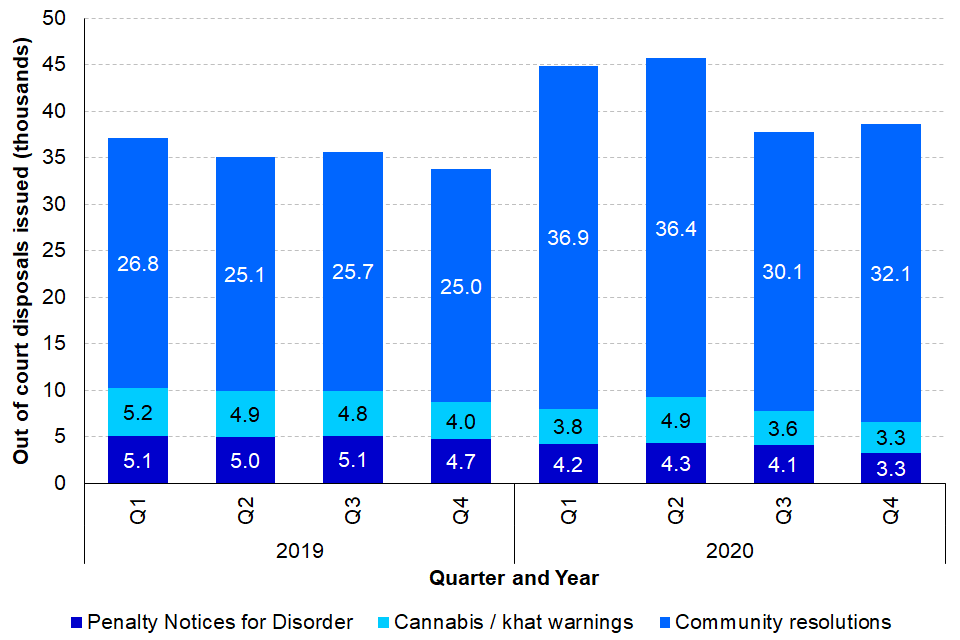
Figure 2: Out of court disposals (excluding cautions) issued, Q1 2019 to Q4 2020, England and Wales (Source: AH_1)
The use of Penalty Notices for Disorder (PNDs) has continued to decline with 16,000 issued in the year ending December 2020, falling 20% from the previous year. The most common offences that resulted in a PND were possession of cannabis, accounting for 43% of PNDs issued, and drunk and disorderly behaviour accounting for 30%.
There were 15,600 cannabis and khat warnings issued, a decrease of 17% from the previous year.
3. Prosecutions and Convictions
Prosecutions at magistrates’ court continued to recover following the impact of the COVID-19 pandemic
Prosecutions fell in Q2 2020, by nearly 60% compared with Q1, but have risen since, doubling between Q2 and Q4. Overall, they were 30% lower in 2020 compared to the previous year.
In 2020, 960,000 defendants were proceeded against at magistrates’ courts, 30% fewer than in 2019. Most of this reduction in prosecutions was a result of reduced court activity during the second quarter of 2020. Prosecutions fell to a low of 21,300 in April 2020, compared with 114,000 in April 2019. Court proceedings began to recover over the rest of the year, with the most serious indictable offences recovering faster than summary offences and reaching similar levels to prior to Covid-19 during from around July 2020.
Figure 3: Prosecutions at magistrates’ courts, monthly by type of offence, England and Wales, January 2019 to December 2020 (Source: Table AH_1)
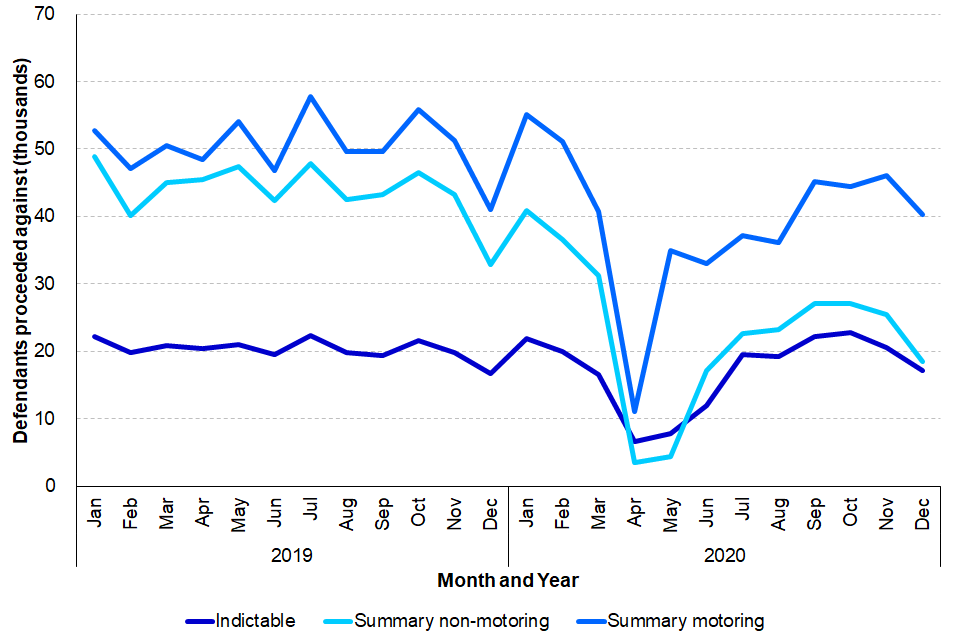
Figure 3: Prosecutions at magistrates' courts, monthly by type of offence, England and Wales, January 2019 to December 2020
The rate of recovery varied across indictable offence groups. Prosecutions for sexual offences were 4% higher in 2020 than in 2019, despite the impact of COVID-19. In the latest year, the number of prosecutions for violence against the person remained stable at 46,500, with a 19% increase in prosecutions for assault of an emergency worker. In contrast, prosecutions for indictable theft offences reduced by 33% to 44,400, largely due to a 41% decrease in prosecutions for theft from shops. Among summary offence prosecutions, the largest decreases were seen in TV licence evasion (55% lower than 2019) and vehicle registration and excise licence offences (66% lower).
Convictions followed the same trend as prosecutions but have recovered less quickly. There were 818,000 offenders convicted at all courts in 2020, down 31% from 2019. Convictions were lower than the previous year across all offence groups. Trends in convictions for indictable offences tend to lag prosecutions due to the time taken between proceedings at magistrates’ and case completion at Crown Court.
4. Remands
The proportion of defendants remanded in custody was at a 5-year high
In the latest year, 11% of defendants were remanded in custody by police prior to appearing at court, 5% were remanded in custody at magistrates’ court, and 40% at the Crown Court.
In the year ending December 2020, 1.02 million defendants were directed to appear at magistrates’ courts (including failures to appear). Over the last 5 years, the proportion of defendants not remanded prior to appearing at magistrates’ court increased to 74% from 68%. The proportion arrested and bailed by the police[footnote 13] decreased to 15% from 23%. The proportion remanded in custody by police remained broadly stable and was 11%.
At magistrates’ court, COVID-19 prioritisation of more serious offences led to the proportion of defendants granted bail and remanded in custody increasing for the first time in 5 years. In the latest year, 18% were remanded on bail, and 5% in custody. This was driven by a large decrease in the number of individuals not remanded.
At Crown Court, the proportion of defendants not remanded continued to increase and the proportion bailed continued to decrease (falling 6 pp in the latest year). The proportion remanded in custody increased 3 pp to 40% in the latest year, which was influenced by the prioritisation of offences likely to result in custody in response to COVID-19.
Figure 4: Defendants’ remand status with Police (prior to court), at magistrates’ courts and at Crown Court, year ending December 2016 to year ending December 2020 (Source: Table Q4.1, Q4.2 & Q4.3)
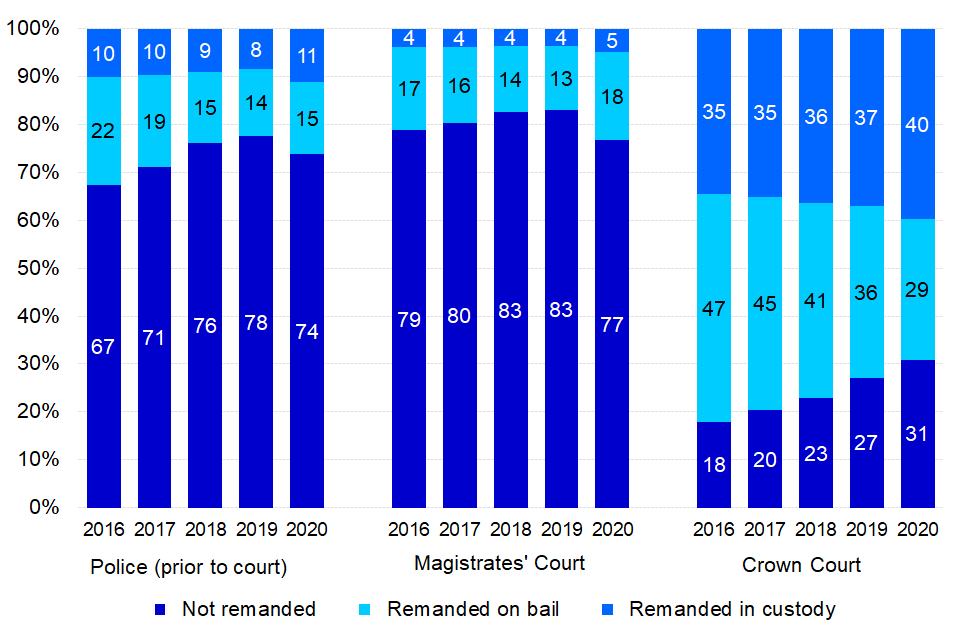
Figure 4: Defendants’ remand status with Police (prior to court), at magistrates’ courts and at Crown Court, year ending December 2016 to year ending December 2020
Defendants are more often remanded in custody for indictable offences than summary offences, so the proportion remanded in custody at Crown Court is higher than at magistrates’ courts. In the latest year, of the defendants remanded in custody at magistrates’ courts, 12% were sentenced to immediate custody, and a further 67% were committed for trial or sentencing at Crown Court. Of those remanded in custody at Crown Court, 76% were sentenced to immediate custody. Of all defendants who were not remanded at Crown Court, 49% received an immediate custody sentence.
5. Sentencing
The overall average custodial sentence length was 18.6 months, remaining stable compared to 2019 which was the highest in the decade
The number of custodial sentences fell by 19% in 2020 to 61,900 but the custody rate increased to 8%, the highest since 2013, driven by courts prioritising more serious offences during COVID-19 that were more likely to receive custodial sentences.
The overall number of offenders sentenced was impacted by the COVID-19 pandemic, resulting in a decrease of 31% in the latest year to 816,000, in line with prosecutions. This was driven by a decline in offenders sentenced for all offence types, although most substantial decreases were for theft and summary offences, which combined accounted for 94% of the decrease.
The total number of sentences continued to generally increase since the low of 17,500 in April 2020, reaching 79,300 in October 2020, then decreased to 64,600 in December 2020 (18% lower than December 2019). Similarly, the relative proportions of sentence types given reached almost pre-COVID levels (Figure 5).
Figure 5: Number and proportions of each sentence type given each month, December 2019 to December 2020 (Source: Table AH_1)
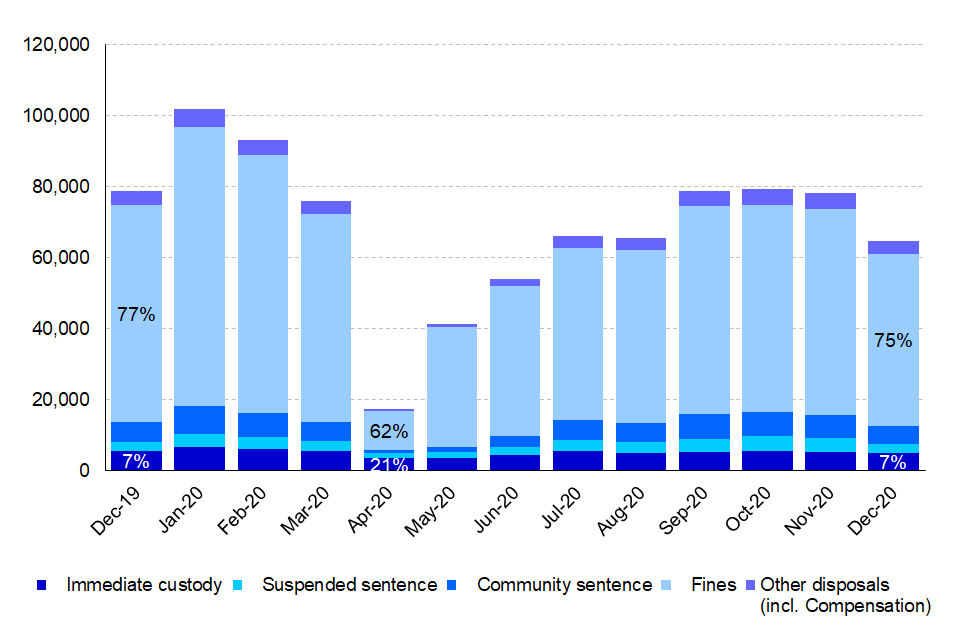
Figure 5: Number and proportions of each sentence type given each month, December 2019 to December 2020 (Source: Table AH_1)
Fines remained significantly the most common sentence, accounting for 76% of all sentences in the latest year. In 2020, the overall custody rate was 8% (peaking at 21% in April due to the prioritisation of serious offences at court in response to the COVID-19 pandemic and a general low level of overall sentences. The custody rate for indictable offences (34%) was the highest in a decade, continuing a long-term increase since 2010. The average custodial sentence length for all offences was 18.6 months, remaining stable compared to 2019 which was the highest in the decade and followed a steady increase since 2010. The trend in ACSL for indictable offences varied by group but remained stable overall.
6. Motoring
The number of prosecutions for motoring offences decreased by 27% from 711,000 in 2019 to 516,000 in 2020, the decrease likely to be influenced by people taking fewer car journeys during restricted movement during the pandemic. Convictions also fell by 27% from 631,000 in 2019 to 463,000 in 2020 with sentencing following the same trend.
Just over half (53%) of prosecutions for motoring offences were for speed limit offences and vehicle insurance offences.
Figure 6: Defendants prosecuted for motoring offences, 2020[footnote 14][footnote 15] (Source: Motoring data tool)
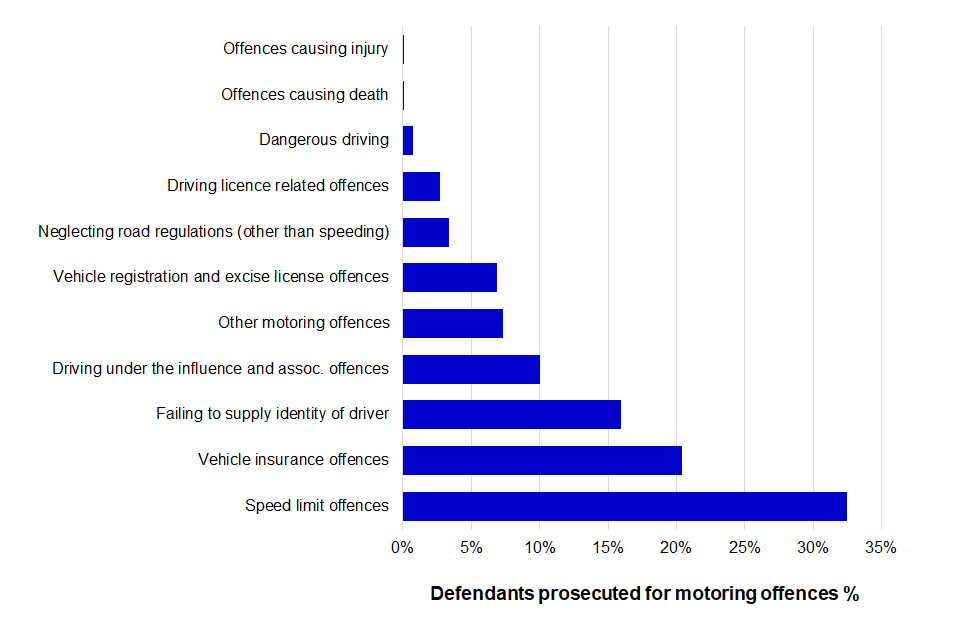
Figure 6: Defendants prosecuted for motoring offences, 2020 (Source: Motoring data tool)
The majority (94%) of motoring offences were dealt with by a fine in 2020, which has remained stable over the last 5 years. The average fine has steadily increased over the last 5 years, from £314 in 2016 to £341 in 2020. The overall custodial rate was 1%, with an average custodial sentence length (ACSL) of 8.7 months which has remained stable in the latest year.
Over the last 5 years, the number of prosecutions for motoring offences which caused death or injury peaked at 914 in 2017 and steadily declined to 757 in 2020. The custody rate fluctuated between 63% and 67% over the last 5 years and was 67% in 2020.
In the latest year, the number of sentenced offenders directly disqualified for motoring offences fell by 15% to 60,200. Of these offenders disqualified, 58% were disqualified for more than a year. A further 317,000 offenders received points on their licence without a disqualification.
Further information
The data presented in this publication are provisional. Final data for each calendar year is published in May, following further data cleaning and the incorporation of additional cases not available in our original extracts of administrative data.
Accompanying files
As well as this bulletin, the following products are published as part of this release:
-
A technical guide providing further information on how the data is collected and processed, as well as information on the revisions policy and legislation relevant to sentencing trends and background on the functioning of the criminal justice system.
-
A set of overview tables, covering each section of this bulletin.
National Statistics status
National Statistics status means that official statistics meet the highest standards of trustworthiness, quality and public value. This bulletin recently underwent a compliance check with the Office for Statistics Regulation and retained its National Statistics status in May 2020[footnote 16]. All official statistics should comply with all aspects of the Code of Practice for Statistics. They are awarded National Statistics status following an assessment by the Authority’s regulatory arm. The Authority considers whether the statistics meet the highest standards of Code compliance, including the value they add to public decisions and debate. It is the Ministry of Justice’s responsibility to maintain compliance with the standards expected for National Statistics. If we become concerned about whether these statistics are still meeting the appropriate standards, we will discuss any concerns with the Authority promptly. National Statistics status can be removed at any point when the highest standards are not maintained and reinstated when standards are restored.
Future publications
Our statisticians regularly review the content of publications. Development of new and improved statistical outputs is dependent on reallocating existing resources. As part of our continual review and prioritisation, we welcome user feedback on existing outputs including content, breadth, frequency and methodology. Please send any comments you have on this publication including suggestions for further developments or reductions in content.
Contact
Press enquiries should be directed to the Ministry of Justice press office:
Tel: 020 3334 3536
Email: newsdesk@justice.gov.uk
Other enquiries about these statistics should be directed to the Data and Evidence as a Service division of the Ministry of Justice:
Damon Wingfield, Responsible Statistician and Head of Criminal Courts & Sentencing Data and Statistics
Ministry of Justice
Email: CJS_Statistics@justice.gov.uk
Next update: 19 August 2021
URL: https://www.gov.uk/government/statistics/criminal-justice-system-statistics-quarterly-december-2020
© Crown copyright
Produced by the Ministry of Justice
Alternative formats are available on request from ESD@justice.gov.uk
-
It is useful to consider an example of a ‘new’ offence to illustrate the delay in court disposals – for example, the offence of stalking came into force in 2012 and in 2013, 53 individuals were convicted for the offence. This rose to 147 in 2014 as more cases flowed through the system and subsequently to 194 in 2015. ↩
-
Update on Coronavirus FPNs issued by police – April 2021 (npcc.police.uk). ↩
-
Cautions have been excluded due to limited access to the Police National Computer as a result of the COVID-19 pandemic. ↩
-
An individual (includes companies) can be counted more than once in a year if dealt with by the CJS on multiple separate occasions. Includes prosecutions, cautions, Penalty Notice for Disorder, cannabis/khat warning and community resolutions. ↩
-
The number of individuals formally dealt with by the CJS is the sum of all defendants prosecuted at magistrates’ court plus all individuals issued an out of court disposal (including community resolutions). ↩
-
Figures for out of court disposals exclude cautions. ↩
-
Following the implementation of a new IT system, Greater Manchester have been unable to supply data since July 2019 so there will be missing data for OOCDs and police charged/summonsed for 2019 and 2020. ↩
-
Review of court arrangements due to COVID-19, message from the Lord Chief Justice. ↩
-
For more information, see Criminal court statistics quarterly: October to December 2020. ↩
-
Following the implementation of a new IT system, Greater Manchester were unable to supply data since July 2019. Therefore numbers of OOCDs presented in this chapter exclude those issued by Greater Manchester Police and will be lower than the national total of OOCDs issued. ↩
-
Excluding Greater Manchester. ↩
-
This may be associated with new legislation under the Policing and Crime Act 2017, which came into force on 3rd April 2017 and introduced a bail limit of 28 days. ↩
-
Other motoring offences includes: Causing danger by interfering with a vehicle, road or traffic equipment, Using or causing others to use a mobile phone whilst driving, Careless driving offences (excl. mobile phone offences), Failing to stop or provide information after accident, Theft of a motor vehicle/aggravated vehicle taking, Work record and employment offences, Fraud, forgery etc. associated with vehicle or driver records, Defective vehicle parts, Vehicle test offences, Miscellaneous (other) motoring offences. ↩
-
The Home Office publishes data in relation to motoring offences including fixed penalty notices (FPNs) for speeding in Police powers and procedures England and Wales statistics. FPNs are out of court disposals where the speeding offence is not serious enough to warrant a criminal court proceeding and where the offender does not contest being issued with the FPN. ↩
-
https://osr.statisticsauthority.gov.uk/correspondence/mark-pont-to-david-blunt-proven-re-offending-and-criminal-justice-system-statistics/ ↩
